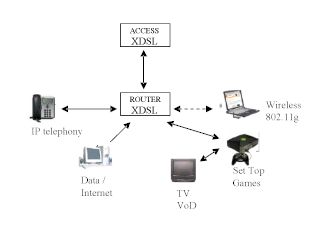|
Among the driving principles behind
innovation toward converging networks, we shall examine the following
five:
Integration of
added-value services
In the traditional TDM switch systems,
the implementation of value-added services is a layer that is external
to the network’s basic architecture. The language that is generally
proprietary of public switching networks must interact in a way that
was not envisaged when it was designed with the generally open
language of the added-value service applications.
This need for integration led to the
designing of a new system that was less complex to administer and that
essentially facilitated portability between platforms of different
providers.
Growing need for
broadband
Furthermore, customers increasingly
need IP access broadband, and this can only be achieved by means of
new architectures arising from a native IP design.
Both considerations, the
implementation of new added-value and growing demand for broadband,
naturally lead to the idea of bringing together all services into a
purely IP network.
With it, the designs of applications
have a natural interface with the nodes that provide traditional
services, which gives the necessary portability between different
network providers.
New forms of
differentiation and profit generation
The principal benefits stemming from
a unified system necessarily include new sources of economic-financial
benefits and market differentiation.
If we divide the public market into
two major segments, residential customers and corporate customers, we
can list some of the benefits that can be obtained from bringing
together carriers and applications into a single IP environment:
Extra benefits for corporate
customers:
-
Billing based on service quality
and service level agreement.
-
Simplicity of VPN service
administration.
-
Advanced video for security systems.
-
Plug-and-play
videoconferencing.
Extra benefits for residential
customers:
-
Self-management and simplicity of
administration.
-
Permanent access to Internet as a
basic service.
-
Video-streaming on demand for tele-education.
-
Commercial TV broadcasting.
-
Basic video for family use
-
Peer-to-peer
applications and access to public video and audio repositories.
The basic scheme for service supply
for a typical customer of an NGN system is as follows:

Reducing the costs
of needed equipment on the customer side
Another element that is speeding up
this customer model is that the manufacturers of customer premise
equipment (CPE) have substantially reduced their cost and have
increased their speed and functionality over the past two years.
For example, suffice it to mention
802.11g (54 Mbps) wireless routers, LAN switch ports, Ethernet WAN
ports, as well as network address translation (NAT) and firewall
functionalities, for a cost under US$100 per end-user.
Existence of Data
Backbone with Broad Capacity and Service Quality
Many service providers have the data
infrastructure that has been growing every year in line with or ahead
of demand. Careful planning of growth makes it possible to consider
new high-speed services on a backbone that originally only carried
data.
What was used as ADSL access a few
years ago for PPPoE services on an ATM network is gradually being
transformed into a carrier service on the IP network.
Service quality plays a fundamental
role to route traffic, such as video and voice, in real time.
Existing data IP backbone as a rule
allow for necessary configuration options that ensure the existence of
service quality policies, which otherwise would render their use
difficult for converging networks.
Aldo Castaña
Catholic University of Uruguay
Universidad Católica del Uruguay
|
Additional Information:
This article is part of the material of the
course New generation converging public networks. CITEL
will offer 15 scholarships of the registration fee for this course
that will be offered, 7 August to
15 September, 2006 by the
Catholic University of Uruguay, through
the platform of the Center of Excellence for the Americas of the
International Telecommunication Union. These
scholarships are subject to the availability of funds
corresponding to the 2006 regular budget.
|
|

